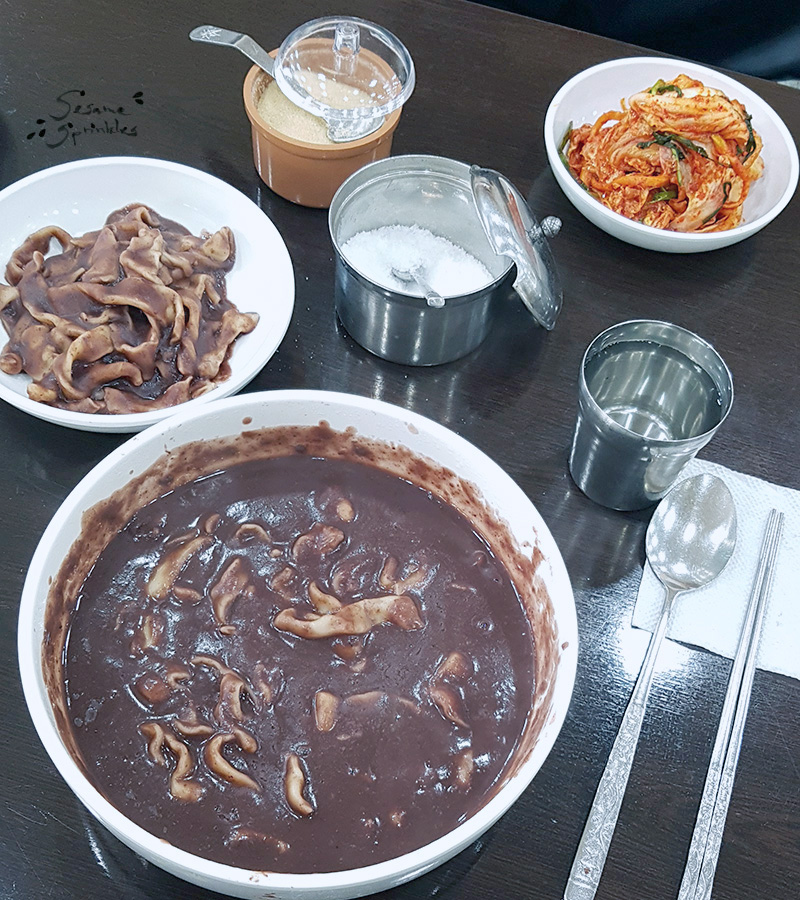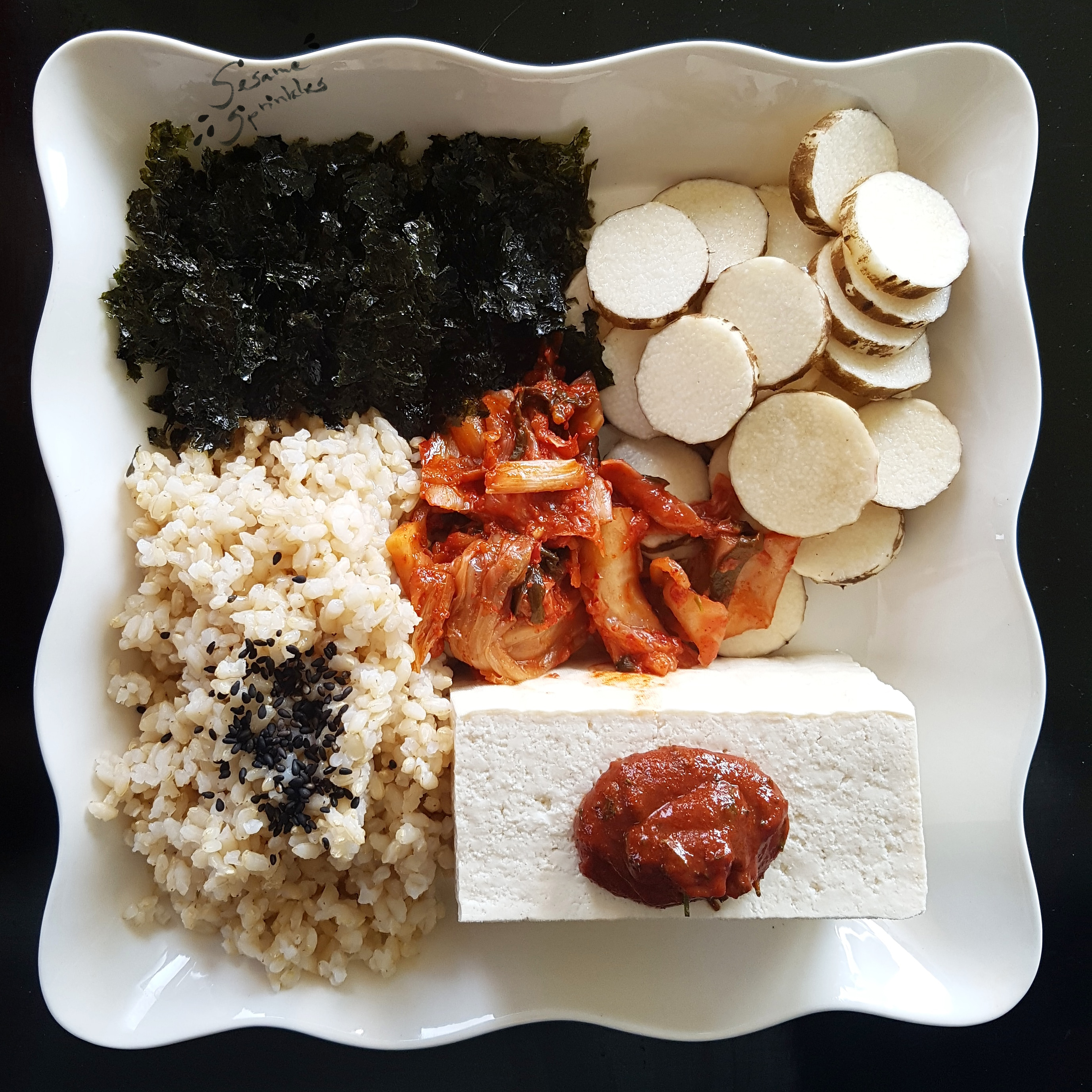Okay, the long title above is no direct translation of the protagonist’s name.
But it’s the first impression on your first date:

Long noodles are swimming in a thick soup with a color resembling milk chocolate. 🍫 The bowl may be steaming from heat, which underlines your association with either hot chocolate or fresh chocolate pudding… 🥣♨️
What is this substance? ❓🤔❔ You wonder.

The base of this soup is nothing less than the famous type of bean called Pat (팥), a characteristic ingredient of Korean [dessert] cuisine. You might be familiar with these red beans from Korean rice cakes (tteok 떡) as well as [Pat]bingsu ([팥]빙수), in which they star as the filling or topping of sweet treats.
And here is another way of serving this versatile and nutritious bean:
Pat-kalguksu (팥칼국수)
This traditional Korean dish is prepared with only a few other ingredients:
Basically, it’s a combination of wheat noodles with a grainy soup of red beans. Overall, Pat-kalguksu is a simple yet very filling meal and it is originally vegan! 🌱 Vegan by default, so to speak.*
If you have previously made acquaintance with Patjuk, then Pat-kalguksu is like his cousin:
Patjuk is essentially red bean porridge with rice cakes, 🍚
Pat-kalguksu is red bean soup with wheat noodles. 🍜
They are related and they share obvious similarities, but they are not quite the same!
Different to hand-pulled noodles (as in e.g. Jjajangmyeon 짜장면), the noodles in this dish, which are called “kalguksu“, are traditionally produced by cutting the dough with a knife🔪 as their name suggests (Korean: kal 칼 – knife; guksu 국수 – noodles).

In general, these Korean noodles are long, flat strips of dough. But the shape of the noodles depends by and large on the skills of their producer:
Home cook👩🍳 VS specialty restaurant’s professional👨🍳 VS factory🏭
In fact, it is a dish, that can be [easily?] made at home! It requires only a few ingredients plus noodle-making skills OR access to good pre-made noodles…
Varying also by location (or preference) is the consistency of the bean broth, i.e. ranging between very thick towards more soupy. Additionally, the skins of the beans may or may not have been removed from the soup. Hence, the texture of the soup can be either smooth and creamy or grainy with chunky pieces of bean skins.

What does Pat-kalguksu taste like? How do you eat it?
Since the dish is served nearly unseasoned, the first spoonful of soup will appear bland or rather “plain”. Koreans call this flavor experience “dambaek hada” (담백하다) – a word which is used to describe the clean and pure flavor of something like milk🥛, tofu🍮, white rice🍚, plain toast🍞 or other types of white bread🥖🥐🥨. It is a flavor that can be appreciated by itself – mostly by purists [or those “boring” eat-nothing-but-vanilla-flavored-ice-cream-people]. After all, the dish also has the subtle earthy aroma of red beans, which you may either love or hate.
Leaving the flavor and aroma aside, the actual taste is up to YOU! 👉😳 Because you are left to add the following seasonings to the neutral base: Salt or sugar! In restaurants, Pat-kalguksu is accompanied with a container of salt and a container of sugar. You can mix salt or sugar (or both!) into your serving and enjoy it either sweet🍭 or savory🧂! Or just as it is – perhaps completely bland. [Follow your personal preference and enjoy individuality, yay!] Any other flavors may be consumed with the side dishes, which normally accompany a serving of Pat-kalguksu.

Regardless of enjoying Pat-kalguksu sweetened or salted, it is a main dish that is very filling. One serving contains many carbohydrates from noodles as well as beans, which also bring plant-based proteins, and it is generally quite nutritious. 💪 Lastly, since it is a soup (albeit it has a rather thick consistency), it will also fill you up with a certain amount of water. 💧
Where can you find Pat-kalguksu?
Interested in meeting Pat-kalguksu after all? Unless you have Pat-kalguksu at home, you can sometimes see Pat-kalguksu in Korean restaurants that specialize in noodle soups. Such restaurants normally mention “kalguksu” (칼국수) or “sujebi” (수제비) in their name, because they are both types of hand-made noodles. 🍜 Alternatively, the restaurant’s name contains the word “mil” (밀), which is Korean for “wheat” and implies that they offer mainly wheat-based dishes such as those featuring noodles.🌾 If you eat out, in the Seoul, the price for Pat-kalguksu lies around 10.000 KRW on average.💲 A regular price for a basic Korean dish.
In conclusion, Pat-kalguksu is not the exciting dish that stimulates your taste buds and takes you on flavorful adventures. He does not add spice to your day, but he will also not leave you alone with watering eyes if you can’t handle the zing of chili or ginger! 🚫🌶 There will also be no bad aftertaste from garlic or onions. 🚫🤢 On the contrary, he may even be considered a softie! Pat-kalguksu is also nothing fancy.

But he’s a grounded guy with a calm character. He will give you a warm hug and a warm belly, when you need it. He is there for you, when you lost your appetite or you are recovering from illness. He provides comfort and fulfills your basic needs, making sure that you are well nourished.
🤗🧡
…And he can also be sweet, if you want him to…😉
Sooooo…. Chocolate-colored noodles anyone?
With salt or with sugar???
.
.
Additional notes from the author
*) Regardless, checking the label (especially for instant products) is advised. Sometimes egg shells🥚 or other animal-derived components are added to noodle products during industrial manufacturing processes.









